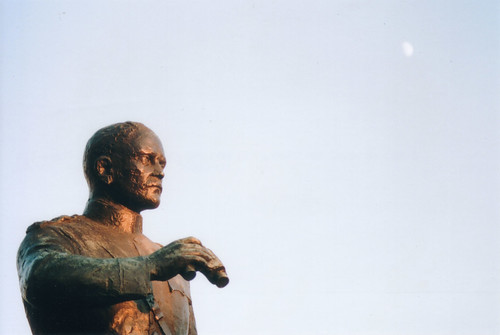
‘Film! – Canon A-1 – Pershing in Focus -11-7-08’
courtesy of ‘mosley.brian’
Few people think much of Pershing Park. I’d wager that most walk by without noticing it. In spite of Pershing Park being DC’s largest World War I memorial, it serves primarily as a napping place for the homeless and a thoroughfare for tourists walking from Federal Triangle station to the White House. You never see people stopping to take pictures or reading the inscriptions on statue pedestals, and the space is a bit disordered and poorly maintained. In and of itself, the park is hardly worth writing about, but it does serve as a disheartening case study of Americans’ indifference towards our nation’s participation in the Great War.
Pershing Park is located on 15th and Pennsylvania, between the Willard and the Commerce building. It was constructed in 1981 by the Pennsylvania Ave. Development Commission in honor of Gen. John J. Pershing and the American Expeditionary Forces. In case you’re a little hazy on your history, Gen. Pershing was one of America’s greatest military minds and “General of the Armies,” the highest rank ever held by any American officer aside from George Washington (although, Washington received this distinction posthumously). Pershing commanded the Expeditionary Forces during World War I and his over all strategy has been credited by many as a deciding factor in the Allied victory of World War I. In the course of a year and a half of combat, his armies suffered over 300,000 casualties, but succeeded in dislodging the Germans from many key locations in Europe.
In some ways, the shaded monument to these men is lovely. It is hewed from red granite and dominated by a shallow, algae filled fountain at one end, and by a bronze statue of Gen. Pershing at the other. Chiseled into the stone are maps and narratives of American exploits during World War I. It’s and unusually informative memorial. Trees surround the area and it seems insulated from the hustle and bustle of Downtown.
But, when you stop and think about it, the design of the space is rather mundane and lacks any sort of cohesion. The fountain area is cluttered and overgrown, while the statue space is stark and featureless. The benches and picnic tables in the park are utilitarian and generic and don’t fit in with the color scheme or feel of the monument. The cobbling of the memorial changes from thick slabs of granite to brick to stone. The fountain basin is in desperate need of cleaning and floods regularly.

‘Pershing Park’
courtesy of ‘NCinDC’
The disorderliness of the design suggest that little thought or aesthetic sense went into it. It seems that the monument is there just to fill space and that the Development Commission approached it as an afterthought. This, coupled with the lack of maintenance and care, is sadly reminiscent of the respect that our nation pays to the memory of our WWI soldiers. There is no major memorial for them on the Mall, despite there being one for almost every other major conflict that the US soldiers died in. We don’t hallow our soldiers’ actions in stories or movies. Very few Americans even know much of the history of WWI.
Truth be told, the conflict was fought in the waning days of a imperialistic mindset that our nation, at least in word, divorced generations ago. WWI was also overshadowed by a second, much larger and more harrowing World War. Still, it was our second costliest war and tens of thousands of men were killed. It completely changed the political landscape of the world, felled empires and revolutionized the way we fight wars. These things are worth remembering.
Accordingly, I take a different view of Pershing Park than I do other monuments. To me, its shabbiness serves as a poignant reminder of America’s forgetfulness. When I think about the tremendous sacrifice of our WWI vets, the very few that remain, Pershing Park reminds me that they deserve a greater respect than we afford. Perhaps it memorializes them in a way that a grandiose, neo-classical edifice never could. The more I think about it, the more moving the it becomes to me. So, next time you’re near the White House, take time to stop at the park, have a look around and remember Gen. Pershing and the American Expeditionary Forces.
Kirk, I like to take my lunch into Pershing Park during nice summer days. When I go, it’s filled with other office workers sitting on the steps doing the same thing. It seems pretty lively to me and I notice tourists reading the inscriptions often. Maybe it’s not wildly popular but I don’t think it’s as shabby as you do.
Maybe for Americans WWII was “more harrowing” than WWI, but in an overall sense, I think Ypres is still considered the worst modern battle. Add in the Somme and Verdun, and it chills the blood. WWI isn’t as easily glorified as WWII, and for good reason. It was one horrifying mess.
Americans don’t have the same perspective on it as Europeans, who lost almost an entire generation of men. I agree that lack of knowledge is a shame.
Perhaps the author is confusing ‘monument’ with ‘memorial’. A monument is a structure or form expressing a single idea. A memorial can be larger, less cohesive, and be composed of many ideas. This doesn’t mean they are less successful, just that it is a different way of remembering. The Vietnam Memorial, the Korean Memorial, the Franklin D Roosevelt Memorial are all examples of memorials that are not expressed in a single shape or form and yet still express sufficient remembrance.